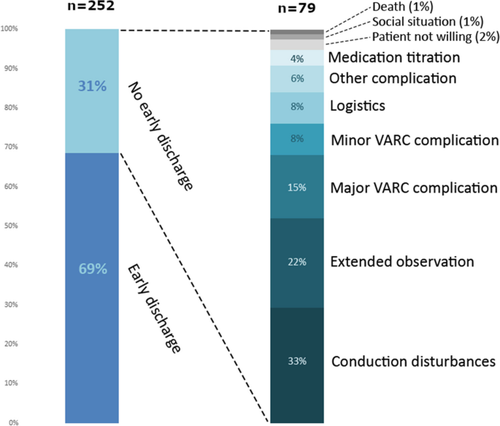Clinical Research in Cardiology ( IF 5 ) Pub Date : 2024-04-15 , DOI: 10.1007/s00392-024-02436-z Joris F. Ooms , Kristoff Cornelis , Harindra C. Wijeysundera , Bert Vandeloo , Jan Van Der Heyden , Jan Kovac , David Wood , Albert Chan , Joanna Wykyrzykowska , Liesbeth Rosseel , Michael Cunnington , Frank van der Kley , Benno Rensing , Michiel Voskuil , David Hildick-Smith , Nicolas M. Van Mieghem

|
Background
Transcatheter aortic valve implantation (TAVI) serves a growing range of patients with severe aortic stenosis (AS). TAVI has evolved to a streamlined procedure minimizing length of hospital stay.
Aims
To evaluate the safety and efficacy of an early discharge (ED) strategy after TAVI.
Methods
We performed an international, multi-center, prospective observational single-arm study in AS patients undergoing TAVI with the ACURATE valve platform. Eligibility for ED was assessed prior to TAVI and based on prespecified selection criteria. Discharge ≤ 48 h was defined as ED. Primary Valve Academic Research Consortium (VARC)-3-defined 30-day safety and efficacy composite endpoints were landmarked at 48 h and compared between ED and non-ED groups.
Results
A total of 252 patients were included. The median age was 82 [25th–75th percentile, 78–85] years and the median Society of Thoracic Surgeons Predicted Risk of Mortality (STS-PROM) score was 2.2% [25th–75th percentile, 1.6–3.3]. ED and non-ED were achieved in 173 (69%) and 79 (31%) patients respectively. Monitoring for conduction disturbances was the principal reason for non-ED (33%). Overall, at 30 days, all-cause mortality was 1%, new permanent pacemaker rate was 4%, and valve- or procedure-related rehospitalization was 4%. There was no difference in the primary safety and efficacy endpoint between the ED and non-ED cohorts (OR 0.84 [25th–75th percentile, 0.31–2.26], p = 0.73, and OR 0.97 [25th–75th percentile, 0.46–2.06], p = 0.94). The need for rehospitalization was similarly low for ED and non-ED groups.
Conclusion
Early discharge after TAVI with the ACURATE valve is safe and feasible in selected patients. Rhythm monitoring and extended clinical observation protracted hospital stay.
Graphical Abstract
Safety and feasibility of early discharge after transcatheter aortic valve implantation with ACURATE Neo, an international multi-center, prospective observational single-arm study. OR, odds ratio (95% confidence interval); VARC, Valve Academic Research Consortium
中文翻译:

ACURATE Neo 经导管主动脉瓣植入后早期出院的安全性和可行性 — POLESTAR 试验
背景
经导管主动脉瓣植入术 (TAVI) 为越来越多的严重主动脉瓣狭窄 (AS) 患者提供服务。 TAVI 已发展成为一种简化的程序,可最大限度地缩短住院时间。
目标
评估 TAVI 后早期出院 (ED) 策略的安全性和有效性。
方法
我们对使用 ACURATE 瓣膜平台接受 TAVI 的 AS 患者进行了一项国际、多中心、前瞻性观察性单臂研究。 ED 的资格在 TAVI 之前根据预先指定的选择标准进行评估。出院≤48小时定义为ED。主瓣膜学术研究联盟 (VARC)-3 定义的 30 天安全性和有效性复合终点在 48 小时确定,并在 ED 组和非 ED 组之间进行比较。
结果
总共包括 252 名患者。中位年龄为 82 [第 25-75 个百分位,78-85] 岁,胸外科医师协会预测死亡风险 (STS-PROM) 评分中位为 2.2% [第 25-75 个百分位,1.6-3.3]。分别有 173 名 (69%) 和 79 名 (31%) 患者实现了 ED 和非 ED。监测传导障碍是非 ED 的主要原因 (33%)。总体而言,30 天时全因死亡率为 1%,新永久起搏器发生率为 4%,瓣膜或手术相关的再住院率为 4%。 ED 和非 ED 队列之间的主要安全性和有效性终点没有差异(OR 0.84 [第 25-75 个百分位数,0.31-2.26],p = 0.73,OR 0.97 [第 25-75 个百分位数,0.46-2.06] ,p = 0.94)。急诊科和非急诊科组的再住院需求同样较低。
结论
对于选定的患者,使用 ACURATE 瓣膜 TAVI 后早期出院是安全可行的。心律监测和延长临床观察延长了住院时间。
图形概要
ACURATE Neo 经导管主动脉瓣植入后早期出院的安全性和可行性,这是一项国际多中心、前瞻性观察性单臂研究。 OR,优势比(95% 置信区间); VARC,阀门学术研究联盟



























 京公网安备 11010802027423号
京公网安备 11010802027423号